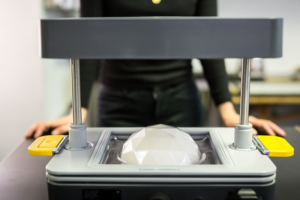3D Printing News Sliced: SHINING 3D, BeAM, Lulzbot, Stratasys, Koffin
 The last Sliced 3D printing news digest of the week, today we feature, a story that brings new meaning for 3D printing a cradle to grave file; new business partnerships from Nano Dimension, EOS, and Authentise; a $9 million research fund; and other additive manufacturing applications, research and hardware releases. Latest business partnerships Process automation […]
The last Sliced 3D printing news digest of the week, today we feature, a story that brings new meaning for 3D printing a cradle to grave file; new business partnerships from Nano Dimension, EOS, and Authentise; a $9 million research fund; and other additive manufacturing applications, research and hardware releases. Latest business partnerships Process automation […]UTEP creates “world first” volumetric circuit with automated 3D printing
 The Electromagnetics and Photonics Lab (EM Lab) of the University of Texas at El Paso (UTEP) has developed an automated process for 3D printing electronics. Incorporating all pre-made components, (e.g. metallic tracks, integrated circuits and transistors) and assembly, the technique enables the fabrication of volumetric circuits with unconventional shapes. EM Lab research assistant Cesar Valle explains, “Typically, […]
The Electromagnetics and Photonics Lab (EM Lab) of the University of Texas at El Paso (UTEP) has developed an automated process for 3D printing electronics. Incorporating all pre-made components, (e.g. metallic tracks, integrated circuits and transistors) and assembly, the technique enables the fabrication of volumetric circuits with unconventional shapes. EM Lab research assistant Cesar Valle explains, “Typically, […]3D Printing News Sliced: Senvol, Betatype, Additive Industries, Hasso-Plattner Institute
3D Printing News Sliced: Stratolaunch, HP, America Makes, iPhone XS
3D Printing News Briefs: August 28, 2018
We’re talking about business, cool products, and events in today’s 3D Printing News Briefs, followed by a how-to video on smoothing your 3D prints and a student competition project. Nano Dimension has sold two of its DragonFly Pro 3D printers to separate branches of the US military, while AIO Robotics has introduced its new silicone drawing mat for 3D printing pens. A 3D printing and design company offered a sneak peek of a new 3D printed golf product, and Rize plans to demonstrate its technology at the upcoming IMTS show. A YouTube video explains how to smooth your 3D prints using automotive primer, and Ogle Models helped a university team complete its prototype for the Unmanned Aircraft Systems Challenge.
Nano Dimension Sells Two More DragonFly Pro 3D Printers
 Israeli additive electronics provider Nano Dimension announced this week that it sold two of its industrial DragonFly 2020 Pro PCB 3D printers to two different branches of the United States Armed Forces. The 3D printer sales were closed by Fathom and TriMech Solutions, two of the company’s top US value added-resellers. This news comes just two months after the company became a certified vendor for the DoD with its Commercial and Government Entity (CAGE) code, which means it can pursue and conduct business directly with the US Federal Government and its agencies.
Israeli additive electronics provider Nano Dimension announced this week that it sold two of its industrial DragonFly 2020 Pro PCB 3D printers to two different branches of the United States Armed Forces. The 3D printer sales were closed by Fathom and TriMech Solutions, two of the company’s top US value added-resellers. This news comes just two months after the company became a certified vendor for the DoD with its Commercial and Government Entity (CAGE) code, which means it can pursue and conduct business directly with the US Federal Government and its agencies.
“Nano Dimension continues to strengthen its position in the U.S. market, particularly in the U.S. defense sector. These sales to tier one customers demonstrate the attractiveness of our additive manufacturing solution,” said Simon Fried, President of Nano Dimension USA. “The ability to create functional circuit prototypes quickly and securely in-house is a key factor in the increasing adoption of our solution in the multi-billion-dollar U.S. defense sector. Nano Dimension’s DragonFly Pro 3D Printer makes it possible to 3D print radically new designs and improve workflows by leveraging the agility of additive manufacturing. The defense sector is highly motivated to enable additive manufacturing in the field by bypassing traditional manufacturing processes.”
AIO Robotics Introduces Silicone Drawing Mat
![]() High-tech startup AIO Robotics, creator of the ZEUS All-In-One 3D Printer, is introducing its latest innovation – a silicone mat perfect for drawing on with your favorite 3D printing pen. The mat, made out of premium, heat-resistant silicone material, is available on Amazon for just $12.99, though you can save 10% on the mat when you also purchase one AIO Pen or an AIO Pen Filament.
High-tech startup AIO Robotics, creator of the ZEUS All-In-One 3D Printer, is introducing its latest innovation – a silicone mat perfect for drawing on with your favorite 3D printing pen. The mat, made out of premium, heat-resistant silicone material, is available on Amazon for just $12.99, though you can save 10% on the mat when you also purchase one AIO Pen or an AIO Pen Filament.
The Silicone Mat for 3D Pen Drawing is perfect for many materials, including PLA, ABS, and PETG, and can be used for simplified but high-precision 3D drawing of grids, circles, and rectangular shapes. When you purchase the mat, you will also receive two free silicone finger protectors, which allow you to safely and easily remove filament from a hot 3D pen tip.
3D Printed Golf Ball Accessory
Out testing our #TeeMate today!#3dprinting #golf pic.twitter.com/xrY6wmSQkW
— Two Bros. 3D Printing Solutions (@2Bros3D) August 26, 2018
3D printing and design company Two Brothers 3D Printing Solutions, based in Massachusetts, offers consulting, 3D printing, and CAD services, and also works hard to, as its website states, “showcase the incredible and affordable technology that is 3D printing.”
“Over the past 4 years, brothers Ryan and Tyler Stacy have spent countless hours learning the ins and outs of 3D printing. Over that time, the two have been able to use 3D printing to create solutions for many different areas; from power tools to prosthetics, replacement parts, birthday gifts, and quite literally, anything in between.”
Earlier this week, the company posted its latest unique 3D printed solution on Twitter – a moveable contraption, called a TeeMate, used to pick up golf balls so golfers do not have to bend down to do it themselves. Fore!
Rize to Showcase Its Technology at IMTS
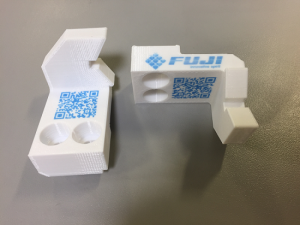 At the upcoming IMTS 2018 show, 3D printing company Rize will be showcasing its technology at the booth belonging to Fuji Machine America Corporation. Rize makes industrial 3D printing safe and easy with its Rize One hybrid 3D printer, and can produce parts that have best-in-class strength in all axes. Additionally, thanks to its unique ink marking capability, the company also provides what it calls “the industry’s only Digitally Augmented Part capability for traceability and compliance.”
At the upcoming IMTS 2018 show, 3D printing company Rize will be showcasing its technology at the booth belonging to Fuji Machine America Corporation. Rize makes industrial 3D printing safe and easy with its Rize One hybrid 3D printer, and can produce parts that have best-in-class strength in all axes. Additionally, thanks to its unique ink marking capability, the company also provides what it calls “the industry’s only Digitally Augmented Part capability for traceability and compliance.”
At IMTS 2018, representatives from Rize and its authorized reseller, Dynamic Machine, will demonstrate the technology’s quick and clean support removal, and explain how the company’s industrial 3D printing can be combined with Fuji’s comprehensive automated manufacturing solutions in order to provide significant cost and time advantages. Come see the Rize One for yourself, and get all your questions answered, at Fuji’s booth #339059 at the IMTS 2018 show, September 10-15 at McCormick Place in Chicago.
Smooth 3D Prints with Automotive Primer
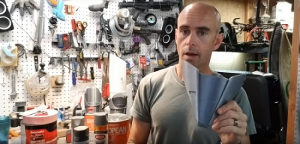 We’ve seen people smooth their 3D prints with epoxy and with acetone, but this is a new one – automotive primer. Youtuber gordontarpley recently published a video about how well it works to smooth your 3D prints with 2k automotive primer, saying that it’s been his “main method for the last few months.”
We’ve seen people smooth their 3D prints with epoxy and with acetone, but this is a new one – automotive primer. Youtuber gordontarpley recently published a video about how well it works to smooth your 3D prints with 2k automotive primer, saying that it’s been his “main method for the last few months.”
“I get asked all the time, ‘How do you clean up your 3D prints?’ and the method always varies. So I’ve been trying to figure out the best way to make a video about that,” Tarpley said.
“Most of the time I go straight from a 3D print…and I will just start with primer. Primer paint and then I’ll paint a layer, sand it, paint, sand, over and over until it looks smooth.”
Tarpley said that’s he learned some valuable information about the primers in this way. To learn more about smoothing your 3D prints with automotive primer, check out the video below:
3D Printed Prototype for Unmanned Aircraft Systems Challenge
 Prototyping company Ogle Models and Prototypes has a history of helping student university teams with their competition projects. Recently, the company worked with a team from University College London (UCL) to create an unmanned aircraft prototype for their entry in the Unmanned Aircraft Systems Challenge, which is held by the Institutions of Mechanical Engineers and designed to develop and inspire the next generation of engineers.
Prototyping company Ogle Models and Prototypes has a history of helping student university teams with their competition projects. Recently, the company worked with a team from University College London (UCL) to create an unmanned aircraft prototype for their entry in the Unmanned Aircraft Systems Challenge, which is held by the Institutions of Mechanical Engineers and designed to develop and inspire the next generation of engineers.
The student team had to design, manufacture, and operate an unmanned aircraft that could complete several tasks simulating a humanitarian mission. The team ran into some issues – in order to endure wind tunnel testing, their prototype would need pressure taps in order to sample air distribution across it. So they called on Ogle for assistance, which recommended SLA 3D printing for the job so they could lower costs by building the taps within the model.
“The accuracy of industrial SLA ensured that the complex geometry of the scaled-down aerodynamic surfaces was replicated with precision. For clarity reasons, the team chose ClearVue resin, which allowed the pressure tapping pathways to be seen on the finished model,” explained Matt White, Senior Sales Engineer at Ogle.
“UCL is regarded as one of the best institutions in the country when it comes to training tomorrow’s mechanical engineers and we were only too happy to help when the team approached us.”
Discuss these stories and other 3D printing topics at 3DPrintBoard.com or share your thoughts in the Facebook comments below.
3D printing news Sliced Hypersonic flight, Xometry, Nano Dimension, Fisher Unitech, Boeing, Bowman International
Nano Dimension Announces Fisher Unitech as Latest Distributor for DragonFly 2020 Pro 3D Printer
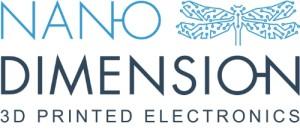 Nano Dimension’s electronic circuit board 3D printers including the DragonFly 2020 Pro have gained a strong new distributor. This year, Nano Dimension has already been steadily amassing customers and distributors. Today, Nano Dimension announced further expansion of its channel through a new partnership with Fisher Unitech, a provider of 3D printers and 3D product development software.
Nano Dimension’s electronic circuit board 3D printers including the DragonFly 2020 Pro have gained a strong new distributor. This year, Nano Dimension has already been steadily amassing customers and distributors. Today, Nano Dimension announced further expansion of its channel through a new partnership with Fisher Unitech, a provider of 3D printers and 3D product development software.
The Michigan-based Fisher Unitech has been around since 1993 and sells products across 22 states. It has 17 offices and caters to more than 17,000 customers.
“Fisher Unitech’s geographical reach, strong position in key verticals and excellent reputation makes them an ideal partner to accelerate our growth in the United States,” said Simon Fried, President of Nano Dimension USA. “We look forward to a long and fruitful relationship with them.”
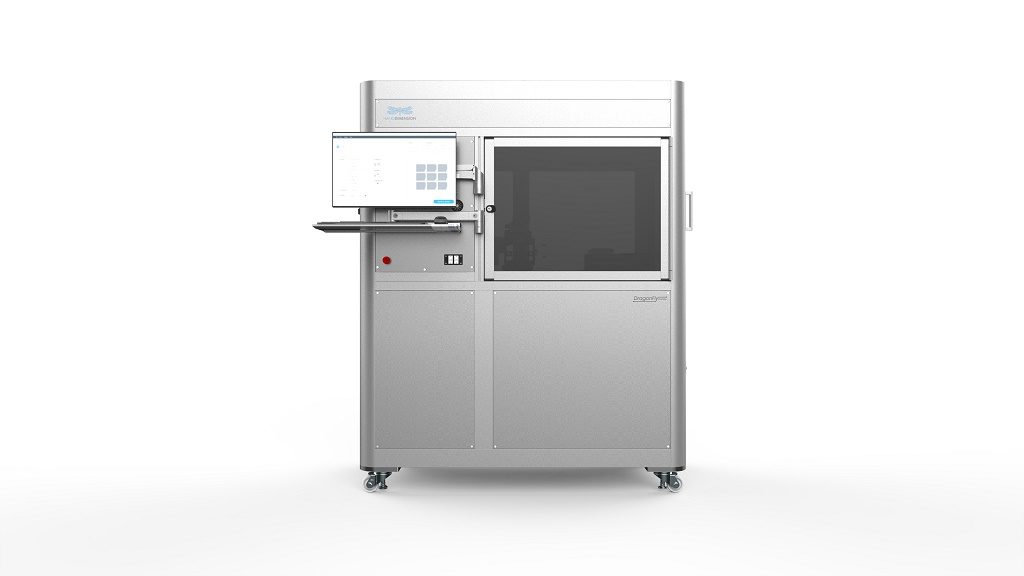 As part of the agreement, Fisher Unitech will purchase the DragonFly 2020 Pro and sell it to its expansive customer base. The 3D printer, in combination with electrical and PCB design software, will provide those customers with a complete embedded electronic solution. This partnership is Nano Dimension’s third channel partnership in North America, and will help the Israel-based company reach further with its sales.
As part of the agreement, Fisher Unitech will purchase the DragonFly 2020 Pro and sell it to its expansive customer base. The 3D printer, in combination with electrical and PCB design software, will provide those customers with a complete embedded electronic solution. This partnership is Nano Dimension’s third channel partnership in North America, and will help the Israel-based company reach further with its sales.
“This partnership represents significant growth potential for both companies. Nano Dimension’s technology forwards our mission to fundamentally advance manufacturing in America by adding the most advanced 3D printed circuit board technology to our customers,” said Matt Wise, CEO of Fisher Unitech. “Circuit boards are an essential element of the Internet of Things and smart connected products. Our industry leading clients strive to design, test and launch products faster than the competition and we are excited to bring them another tool to accelerate that process.”
 Fisher Unitech also sells Stratasys and MakerBot 3D printers, along with Artec 3D scanners and a variety of software. In addition, the company offers training in the form of SOLIDWORKS classes and professional certifications.
Fisher Unitech also sells Stratasys and MakerBot 3D printers, along with Artec 3D scanners and a variety of software. In addition, the company offers training in the form of SOLIDWORKS classes and professional certifications.
The DragonFly 2020 Pro allows for the 3D printing of functional electronics such as sensors, conductive geometries, antennas, molded connected devices, printed circuit boards and more. 3D printing these devices enables time and cost savings, fast prototyping and short-run manufacturing In addition to the Dragonfly 2020 Pro 3D printer, Nano Dimension also offers several conductive nanoparticle inks and dielectric inks. The company has also announced its plans to develop ceramic 3D printing technology in the future.
NanoDimension is working hard to place itself at the crossroads of IoT and 3D printing. By working hard to win distributors it is building a global channel. Other firms are focusing on the direct model which may leave leads on the table but will get them higher margins. Which is the right choice?
Discuss this and other 3D printing topics at 3DPrintBoard.com or share your thoughts below.
Nano Dimension and Mayku Announce New Strategic and Distribution 3D Printing Partnerships
 Israeli additive electronics provider Nano Dimension announced in April that it would be expanding its coverage in the Asia Pacific (APAC) region, and today has made good on that announcement. The award-winning company has officially entered the Chinese market now, thanks to its strategic partnership with top 3D printer distributor the AURORA Group.
Israeli additive electronics provider Nano Dimension announced in April that it would be expanding its coverage in the Asia Pacific (APAC) region, and today has made good on that announcement. The award-winning company has officially entered the Chinese market now, thanks to its strategic partnership with top 3D printer distributor the AURORA Group.
The AURORA Group is the majority shareholder of 3D software and 3D printer provider General Integration Technology (GIT), which recently purchased and installed a DragonFly 2020 Pro PCB 3D printer from Nano Dimension for its Taiwan showroom. In addition to this new partnership, AURORA has also purchased a second DragonFly 2020 Pro.
“China is one of the world’s largest and most important electronics manufacturing and design markets, and establishing the correct foothold in the market is key for Nano Dimension. AURORA has years of operating experience in the manufacturing sector, and with its extensive resources and unique network of 1,500 offices, 300,000 customers, including more than 3,000 customers in electronics industries, we believe it is very well positioned to give us fast market access to realize the full potential of the DragonFly 2020 Pro in China,” said Amit Dror, CEO of Nano Dimension. “We look forward to developing the Chinese market together by leveraging AURORA’s significant presence.”
As a result of the partnership, AURORA will market and sell the DragonFly 2020 Pro to customers in China, which will help grow Nano Dimension’s market coverage in APAC.
“Providing our customers with the very latest in high-quality, innovative 3D printing solutions is key to the success of our company,” said Daniel Chi, GM of 3D Business Unit, AURORA Group. “Forming a strategic relationship with Nano Dimension helps us expand our offering to now include capabilities for 3D printing electronics. The Nano Dimension DragonFly 2020 Pro is a groundbreaking technology that opens unimagined possibilities for electronics designers and manufacturers.”
A January 2018 market research report from the International Data Corporation (IDC) shows that the quickly growing Chinese 3D printing market is leading Asia. 3D printing in the country benefits from both industrial and private consumer investments and government support, so partnering with AURORA for additional APAC coverage is a smart move on Nano Dimension’s part.
“This is an important moment for our recently established Hong Kong office,” said Nano Dimension’s APAC Director Gilad Reshef. “We are proud to partner with AURORA as our leading partner in China. The partnership with AURORA deepens AURORA’s exposure to additive manufacturing by expanding into 3D-printing electronics, paving the way for new markets and applications.”
This news from Nano Dimension and AURORA isn’t the only newly announced 3D printing partnership. London startup Mayku has just released its innovative desktop vacuum former, the FormBox, for sale in the UK and the US, with help from its own new partner – 3D printing specialist GoPrint3D.
“We’re really excited about it as we think a lot of 3D printer owners will want one to complement their existing 3D printer,” GoPrint3D’s David Whitehouse told 3DPrint.com.
GoPrint3D, which is also a distributor for EnvisionTEC and learnbylayers, was launched six years ago as a part of Express Group Ltd, which has provided 2D printer repair and spare parts to the UK for three decades. The company sells, repairs, and hires 3D printers, in addition to providing professional services.
“We were so impressed when we first saw the FormBox that we immediately backed it on Kickstarter,” explained Jo Young, Managing Director at GoPrint3D. “Now we are a partner as well as a backer. It’s the perfect accessory to 3D printers like the Form 2 so we are delighted to add it to our range.”
In 2016, Mayku crushed its original $50,000 Kickstarter campaign goal for the FormBox by over 1,000%. The desktop vacuum forming machine, which can be powered by a vacuum cleaner, lets makers and designers create items in all sorts of materials, ranging from concrete, ice, and plaster to soap, chocolate, and wax, and others as well.
The machine is user-friendly, and fast as well – able to make molds in just minutes without having to rely on any additional software or digital model manipulation.
“Vacuum forming was previously something found in makerspaces and in schools due to their cost and size,” explained Ben Redford, Mayku’s Co-Founder and CPO. “We are thrilled to have the support of the 3D printing industry and have been blown away with what makers have been designing.”
The FormBox is a complementary new hardware addition for 3D printer owners. Users can easily vacuum form a 3D print using the FormBox, which can then be used as a mold for fast replication in multiple materials that are not able to be directly 3D printed at this time.
GoPrint3D now has the FormBox in stock and available for purchase for a price of £499 excluding VAT.
Discuss partnerships and other 3D printing topics at 3DPrintBoard.com or share your thoughts in the Facebook comments below.





